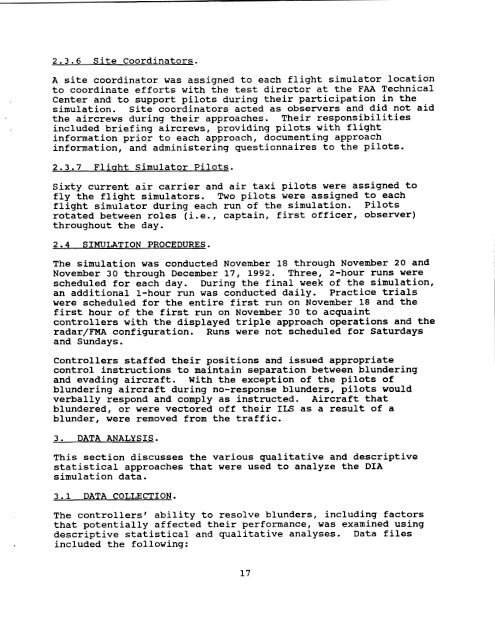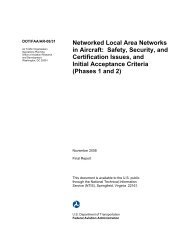Published Report (DOT/FAA/CT-94-36)
Published Report (DOT/FAA/CT-94-36)
Published Report (DOT/FAA/CT-94-36)
You also want an ePaper? Increase the reach of your titles
YUMPU automatically turns print PDFs into web optimized ePapers that Google loves.
2.3.6 Site Coordinators.<br />
’<br />
A site coordinator was assigned to each flight simulator location<br />
to coordinate efforts with the test director at the <strong>FAA</strong> Technical<br />
Center and to support pilots during their participation in the<br />
simulation. Site coordinators acted as observers and did not aid<br />
the aircrews during their approaches. Their responsibilities<br />
included briefing aircrews, providing pilots with flight<br />
information prior to each approach, documenting approach<br />
information, and administering questionnaires to the pilots.<br />
2.3.7 Fliuht Simulator Pilots.<br />
Sixty current air carrier and air taxi pilots were assigned to<br />
fly the flight simulators. Two pilots were assigned to each<br />
flight simulator during each run of the simulation. Pilots<br />
rotated between roles (i.e., captain, first officer, observer)<br />
throughout the day.<br />
2.4 SIMULATION PROCEDURES.<br />
The simulation was conducted November 18 through November 20 and<br />
November 30 through December 17, 1992. Three, 2-hour runs were<br />
scheduled for each day. During the final week of the simulation,<br />
an additional l-hour run was conducted daily. Practice trials<br />
were scheduled for the entire first run on November 18 and the<br />
first hour of the first run on November 30 to acquaint<br />
controllers with the displayed triple approach operations and the<br />
radar/FMA configuration. Runs were not scheduled for Saturdays<br />
and Sundays.<br />
Controllers staffed their positions and issued appropriate<br />
control instructions to maintain separation between blundering<br />
and evading aircraft. With the exception of the pilots of<br />
blundering aircraft during no-response blunders, pilots would<br />
verbally respond and comply as instructed. Aircraft that<br />
blundered, or were vectored off their ILS as a result of a<br />
blunder, were removed from the traffic.<br />
3. DATA ANALYSIS.<br />
This section discusses the various qualitative and descriptive<br />
statistical approaches that were used to analyze the DIA<br />
simulation data.<br />
3.1 DATA COLLE<strong>CT</strong>ION.<br />
The controllers‘ ability to resolve blunders, including factors<br />
that potentially affected their performance, was examined using<br />
descriptive statistical and qualitative analyses. Data files<br />
included the following:<br />
17

















